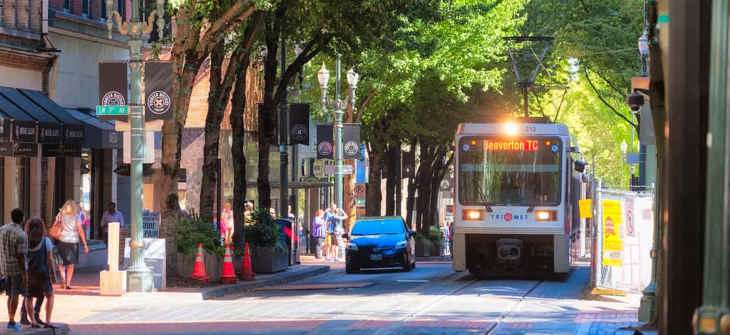
Ups of Street Trees and Downs of Leaves
Enjoying a spectacular fall in Portland, Oregon leads me to talk about street trees and leaves.
As we all know the value of trees extends well beyond stormwater management. Urban trees provide numerous benefits including providing wildlife food and habitat, reduction of the heat island effect (up to 4 degrees C) and reduction in CO2 emissions and improvement to urban air quality through the sorption and deposition of atmospheric aerosol and particulates. Trees also add significant aesthetics, increased property values, noise reduction and increased privacy.
Street trees also provide multiple benefits in our efforts to address stormwater quantity and quality. These include the direct interception of rainfall in the leaf canopy (that is why you stand under a tree when caught out in rainfall – it acts as an umbrella). When the interception capacity is exceeded the transference of rainfall down the branches and trunk and dripping from leaves results in lower detachment energy to reduce erosive forces. Tree root systems, especially fibrous ones increase infiltration and evapotranspirative processes to reduce runoff volumes.
Available data from the U.S. Pacific northwest indicates that interception by evergreen trees can range from 18 – 25% of annual rainfall. In addition, the percentage of precipitation transpired by conifer trees may be close to 10%. (Herrera Environmental Consultants, 2008).
Fallen leaves help form a spongy layer (duff) that moderates soil temperature, helps maintain soil moisture and provides habitat for organisms that break down organic matter and recycle elements for use in plant growth. This duff layer allows rainwater to percolate into the soil rather than being conveyed as overland flow.
Don’t get me wrong, I love trees and support the use of them in the urban environment till the cows come home. As a resident of a city blessed with many street trees in the downtown area, I would not have it any other way. Like all other things, there can be issues associated with these benefits, especially in the urban environment. So I point out the following, especially for deciduous trees, to make sure the detriments are part of the design and management process.
Tree roots, in their desire to seek water in a water-constrained environment, can be destructive to pavement, sidewalks and underground and areal utilities not only a maintenance issue but can be a hazard to pedestrians. Thankfully, recent developments of permeable pavers and structured soils can help alleviate this issue. The scaffold can obstruct sighting distance for vehicles and interfere with overhead utilities so urban horticulturists need to be consulted to fully understand the trees mature size and canopy geometry. Trees need TLC such as pruning, fertilization, pest control, etc. Urban horticulturists have techniques to properly manage the trees without having a risk of putting more pollutants into the environment.
Tree leaves which fall to the ground and become forest duff are part of a delicate nutrient cycle and provide great benefit for water quality, and natures hydrologic management. However, trees growing in a highly constrained impervious area with leaves falling onto a paved surface are not beneficial for a number of reasons.
Fallen leaves clog storm drains and can cause localized flooding. Leaves can clog inlets to bioretention facilities and reduce their effectiveness. Frequent maintenance, especially following fall leaf drop helps. Municipalities need to be prepared to have a street leaf collection program often conscript local residents to clear the drains in a big storm. The leaves, berries, etc can be slippery and a hazard to cyclists (myself having the unfortunate experience) pedestrians and vehicles. Select the right trees and keep the travel ways clear.
The leaves can effectively blanket the surface of an infiltration facility and reduce the design infiltration rate. Frequent collection helps, and biodegradation will eventually help as well. Eventually, these leaves will decompose and actually benefit the function of the facility. The leaves, flower shatter, and pollen can add a significant volume of organic matter, nutrients, and carbon to sensitive water bodies and cause issues with DO and nitrification. Plant selection and perhaps more pretreatment for water quality facilities; e.g. a screening system upstream of a pond should be considered to mitigate these issues.
However, fallen leaves have a benefit as well. Tannins and fulvic acids from decaying leaves will sequester soluble metals in ligands and reduce the overall metals toxicity of water. The Ca, Mg, and Na salts from the decayed matter will contribute to the hardness of the water and decrease toxicity as well. Most importantly, the color and crackle of the leaves under your bike tires on a cool fall ride is hard to beat.
